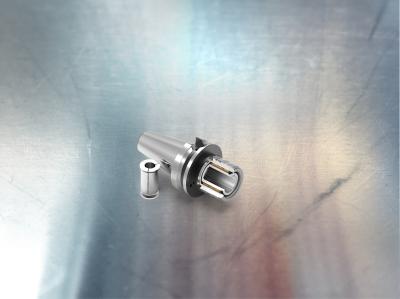
Shops that seek to maximize milling performance while they reduce tooling inventories will benefit from newly introduced Power Milling Chucks from Seco Tools. With holding power and transmittable torque that rival hydraulic and shrink-fit holders, Power Milling Chucks deliver high precision with 5-micron runout accuracy at 3 times diameter in addition to enhanced application flexibility and cost effectiveness.
Through direct clamping technology, one Power Milling Chuck can hold cylindrical shank 0.75" and 1.25" (20 mm, 32 mm) diameter tools and Weldon shank tools of 0.75" (20 mm) diameters. With the use of reduction sleeves, the chuck accommodates shank diameters in cylindrical plain, Weldon and Whistle Notch tools from 0.25" up to 1.00" (6 mm up to 25 mm). These chucks secure milling tools for roughing and finishing operations, as well as drilling and tapping tools.
To avoid the clamping problems often associated with the steel-to-steel contact on collet chucks, Seco created Power Milling Chucks with numerous innovative advantages, including a nut and needle-bearing design for superior clamping power with minimal tightening force/torque requirements.
Optional coolant-stop screws enable Power Milling Chucks to engage through-tool coolant with no additional expense of ancillary equipment such as heating or hydraulic units.
Seco makes Power Milling Chucks for HSK-A, Seco-Capto, DIN, BT and BT taper-face, and ANSI (CAT) and ANSI (CAT) taper face spindle interfaces. Each chuck includes spanner wrench, stop screw and operating instructions, with a hook spanner for sleeve extraction available as a separate option.
Contact Details
Related Glossary Terms
- chuck
chuck
Workholding device that affixes to a mill, lathe or drill-press spindle. It holds a tool or workpiece by one end, allowing it to be rotated. May also be fitted to the machine table to hold a workpiece. Two or more adjustable jaws actually hold the tool or part. May be actuated manually, pneumatically, hydraulically or electrically. See collet.
- collet
collet
Flexible-sided device that secures a tool or workpiece. Similar in function to a chuck, but can accommodate only a narrow size range. Typically provides greater gripping force and precision than a chuck. See chuck.
- coolant
coolant
Fluid that reduces temperature buildup at the tool/workpiece interface during machining. Normally takes the form of a liquid such as soluble or chemical mixtures (semisynthetic, synthetic) but can be pressurized air or other gas. Because of water’s ability to absorb great quantities of heat, it is widely used as a coolant and vehicle for various cutting compounds, with the water-to-compound ratio varying with the machining task. See cutting fluid; semisynthetic cutting fluid; soluble-oil cutting fluid; synthetic cutting fluid.
- gang cutting ( milling)
gang cutting ( milling)
Machining with several cutters mounted on a single arbor, generally for simultaneous cutting.
- milling
milling
Machining operation in which metal or other material is removed by applying power to a rotating cutter. In vertical milling, the cutting tool is mounted vertically on the spindle. In horizontal milling, the cutting tool is mounted horizontally, either directly on the spindle or on an arbor. Horizontal milling is further broken down into conventional milling, where the cutter rotates opposite the direction of feed, or “up” into the workpiece; and climb milling, where the cutter rotates in the direction of feed, or “down” into the workpiece. Milling operations include plane or surface milling, endmilling, facemilling, angle milling, form milling and profiling.
- shank
shank
Main body of a tool; the portion of a drill or similar end-held tool that fits into a collet, chuck or similar mounting device.
- tapping
tapping
Machining operation in which a tap, with teeth on its periphery, cuts internal threads in a predrilled hole having a smaller diameter than the tap diameter. Threads are formed by a combined rotary and axial-relative motion between tap and workpiece. See tap.

